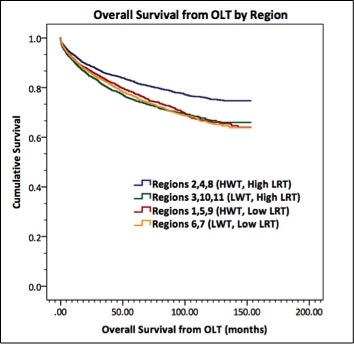Independent Prognostic Factors for Survival in Hepatocellular Carcinoma Patients Undergoing Orthotopic Liver Transplantation: UNOS Population Study
Interventional Radiology, Department of Radiology, University of Pittsburgh School of Medicine, Pittsburgh, PA.
Meeting: 2015 American Transplant Congress
Abstract number: 311
Keywords: Hepatocellular carcinoma
Session Information
Session Name: Concurrent Session: Liver Transplantation for Hepatocellular Carcinoma
Session Type: Concurrent Session
Date: Monday, May 4, 2015
Session Time: 4:00pm-5:30pm
 Presentation Time: 4:00pm-4:12pm
Presentation Time: 4:00pm-4:12pm
Location: Room 113-BC
Background: The impact of regional differences in bridging locoregional therapy (LRT) use and wait times on overall survival (OS) in hepatocellular carcinoma (HCC) patients undergoing orthotopic liver transplantation (OLT) have not been investigated in large-scale population studies.
Methods: HCC patients listed for OLT from 2002-2013 and transplanted up to 2014 were identified on the United Network for Organ Sharing (UNOS) database. Patients within Milan Criteria with approved HCC MELD exception were included. OS was stratified by UNOS regions with high mean wait times (HWT; defined as >180 days), low wait times (LWT), high rates of LRT (defined as >25% of patients with ≥1 LRT) and low LRT use. Kaplan-Meier and Cox proportional hazard models were used for survival analysis.
Results: Of 17291 patients with HCC listed for OLT, 14511 received OLT, mean age 57.4 yrs, 76.8% male; 3889 received LRT. Comparison groups were similar for gender, race, body mass index (BMI), etiology of HCC, biological MELD scores and warm ischemic time (p>0.05 for all). Significant differences in mean OS in regions with HWT/high LRT (122.4 mo), HWT/low LRT (104.5 mo), LWT/high LRT (104.2 mo) and LWT/low LRT (102.3 mo) were observed, p=0.0006.  Recipient age, donor age, bridging LRT and longer wait times were found to be independent prognostic factors of survival from OLT.
Recipient age, donor age, bridging LRT and longer wait times were found to be independent prognostic factors of survival from OLT.
| Prognostic Factor | Parameters Compared | Univariate Analysis HR (95% CI) | p-value | Multivariate Analysis HR (95% CI) | p-value |
| Age | >65 vs. ≤65 years | 1.71 (1.44-2.94) | <0.001 | 1.37 (1.23-1.54) | <0.001 |
| Donor Age | >45 vs. ≤45 years | 1.86 (1.67-2.19) | <0.001 | 1.38 (1.30-1.58) | <0.001 |
| Gender | Male vs. Female | 0.80 (0.26-2.45) | 0.61 | – | – |
| Donor Gender | Male vs. Female | 1.28 (0.41-3.98) | 0.69 | – | – |
| Body Mass Index (BMI) | >25 vs. ≤25 | 1.02 (0.39-2.65) | 0.97 | – | – |
| Bridging LRT | Present vs. Absent | 2.45 (1.93-2.49) | <0.001 | 2.28 (1.32-3.14) | 0.003 |
| Wait Time | ≤180 vs. >180 days | 2.69 (1.77-3.40) | <0.001 | 2.41 (1.25-3.26) | <0.001 |
| Etiology of HCC | Hepatitis B/C vs. Other | 1.45 (0.33-6.44) | 0.62 | – | – |
Conc: In HCC patients undergoing OLT, age, donor age, high wait times and bridging LRT were significant independent prognostic factors for survival.
To cite this abstract in AMA style:
Xing M, Kim H. Independent Prognostic Factors for Survival in Hepatocellular Carcinoma Patients Undergoing Orthotopic Liver Transplantation: UNOS Population Study [abstract]. Am J Transplant. 2015; 15 (suppl 3). https://atcmeetingabstracts.com/abstract/independent-prognostic-factors-for-survival-in-hepatocellular-carcinoma-patients-undergoing-orthotopic-liver-transplantation-unos-population-study/. Accessed December 7, 2025.« Back to 2015 American Transplant Congress
